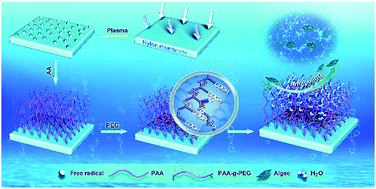Design of hierarchical comb hydrophilic polymer brush (HCHPB) surfaces inspired by fish mucus for anti-biofouling†
Abstract
Anti-biofouling surfaces are of high importance owing to their crucial roles in biosensors and biomedical devices, especially in the marine industry. However, traditional anti-biofouling surfaces based on either the release of biocidal compounds or surface peeling will contaminate the environment. The outstanding performances of natural anti-biofouling surfaces motivate the development of new bioinspired antifouling surfaces. Herein, a universal strategy inspired by the special performance of fish skin mucus is proposed for rationally designing anti-biofouling surfaces using grafted hierarchical comb hydrophilic polymer brushes (HCHPBs) on plastics and elastomers. The results show that the plastic substrate surface grafted PAA (polyacrylic acid)-g-PEG (polyethylene glycol) (MW 2000, 6000, and 11 000 Da) exhibits excellent hydrophilic and underwater oleophobic properties, and also shows good performance in terms of lubricity and drag reduction in water, which can be attributed to the HCHPB and the nanostructure on plastic surfaces. In addition, the modified substrate shows superior and long-lasting anti-biofouling properties to resist the adhesion of algae compared to the initial substrate. This comprehensive investigation is of great importance to understand the physicochemical properties of hierarchical comb hydrophilic polymer brushes and the mechanism against the adhesion of marine microorganisms.



 Please wait while we load your content...
Please wait while we load your content...